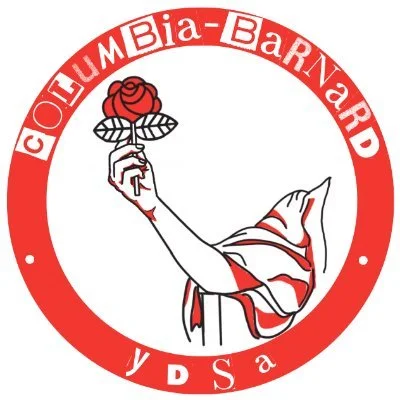

Tuition Strike Continues! Join our Day of Action
A few days ago we held a vote open to all tuition strikers about whether to continue the strike past the next payment deadline of March 18. Similar to our vote in February, students were overwhelmingly in favor of continuing the strike, with 82% voting to continue and hundreds of students participating in the vote. The majority of those students were personally committed to continuing to withhold their tuition payments.
With the Graduate Workers of Columbia going on strike the same week that we are announcing the continuation of our tuition strike, we are in an uniquely strong position. We’ve shown the administration that we aren’t going away until they give us a real plan for how our demands will be met.
But now we need to continue organizing to put as much pressure on the administration as possible. Here are some ways you can help the effort:
- Take action by calling and emailing administrators, emailing all of your past and current professors to ask them to sign our open letter in support, getting in touch with all alumni you know to ask them to sign our alumni open letter / no-donation pledge and to join our email/call campaign. You can find all of this on our action guide: https://bit.ly/tuition-action
- Come to our Day of Action, Friday March 18th, 4-5 pm ET to put pressure on administration and organize our networks together! (RSVP for Zoom info here)
- Sign up for a working group to help us organize actions, press outreach, and coalition-building.
- Donate to our strike fund. Thanks to all the donations we’ve raised from supporters across the country, we will likely have the funds to cover late fees for everyone who requests them and who is unable to obtain a waiver. We’ve put together this script for requesting late fee waivers from Columbia offices, and if you are unable to obtain a waiver and need funds to cover late fees, you can request them here.
You can also come to our Tuition Strike General Body Meeting this Thursday, 8 pm ET (RSVP for Zoom info here) to discuss strategy, next steps, and ways to get involved with the effort.
Hope to see you at our Day of Action and as always feel free to reach out to us at columbia.ydsa@gmail.com to talk more!


The Union Makes Us Strong with Adolfo Abreu
Essential workers have been carrying a pandemic stricken New York City on their backs for a year now, and as economic insecurity worsens and the time frame left to address the overlapping climate crisis shortens, there’s never been a moment more ripe, and necessary for militant labor organizing. On tonight’s episode we’ll hear from NYC-DSA endorsed City Council candidate Adolfo Abreu about what essential workers in his Bronx community need and how the NYC-DSA slate plans to build long term working class power. We’ll also talk to Daniel Dominguez of DSA-Los Angeles about how DSA members and unionists across the country are organizing for the PRO- ACT, the most comprehensive labor legislation reform in generations.
Listen to our September 2020 show about the fight to stop the NRG plant in Astoria: https://revolutionsperminute.simplecast.com/episodes/stop-the-astoria-power-plant, then submit a public comment to support the ongoing struggle: bit.ly/noNRGplant.
Learn more about and get involved with Adolfo Abreu’s campaign for city council: https://adolfo.nyc/
Sign up to get involved with DSA’s national campaign to pass the PRO Act: https://www.dsausa.org/proact/


Response to Provost Katznelson and How You Can Support the GWC Strike
We are calling on all supporters of the tuition strike to also support the Graduate Workers of Columbia in their upcoming strike. Provost Ira Katznelson sent out a misleading email on Monday trying to pit students against the workers. But we and thousands of other students understand that the working conditions of our teaching assistants directly impacts students’ learning conditions. If you support Columbia academic workers on strike, please add your name to this petition to show the workers and the Columbia administration that students and workers stand together.
Ira Katznelson writes that the GWC’s decision to call for a work stoppage is “regrettable” and “unnecessary,” but in fact it is a last resort that they have been pushed to by the administration’s unwillingness to meet their very reasonable and necessary demands for a living wage, protection from harassment, union protection, and full recognition of all academic student-workers.
Katznelson’s email argues that doctoral workers’ compensation is comparable to that at other institutions. This is false, as rates for hourly pay are significantly lower than at other NYC institutions like CUNY and NYU, and compensation for Ph.D. students on 9-month appointments is lower than at NYU. Katznelson and the Columbia administration obscures the reality that attending Columbia requires incurring a uniquely high cost of living. Even after housing subsidies, the vast majority of graduate workers spend over 40% of their total compensation on rent, which is neither sustainable nor paralleled at peer institutions. If it’s neither “reasonable” nor “responsible” to pay student workers living wages under the current budget, is it “reasonable” or “responsible” to continue paying seven-figure salaries to administrators and pursuing multi-billion-dollar expansion and renovation projects?
On the issue of harassment and discrimination, Katznelson writes that the union and the university are “not adversaries,” yet the university’s counterproposal on this issue would maintain Columbia’s unchecked decision-making power and would prevent any real recourse for cases of power-based harassment.
The issue of union recognition tells a similar story. The administration refuses the GWC a union shop model, which nearly all graduate unions in private universities (as well as all other unions at Columbia) have. Moreover, the university still refuses to recognize entire groups of student-workers as part of the union.
Katznelson’s email demonstrates how fearful the administration is of the power that GWC wields through a strike, which is so potent precisely because these students’ work is absolutely necessary to the university’s functioning.
If you want to support the strike, here are some ways you can help out with the effort:
- DO NOT report your striking instructors or TAs to their department, to faculty, or to administration. Deans Valentini and Rosen-Metsch have recently sent out an email encouraging students to ‘contact the relevant academic department for further information or instructions’ if their instructor is on strike. This is the administration’s disingenuous way of saying that they are relying on students to report their striking instructors in order to potentially retaliate against them by reducing their stipends and financial aid.
- Sign this solidarity petition in support of the strike and share with all other Columbia students you know!
- Send an email to Provost Katznelson using this script!
- Send a letter in support of student-workers’ demands!
- Join the picket lines (and bring some friends)! (in-person picket sign up; virtual picket sign up)
- If you are an academic student-worker (including undergraduate and Master’s TAs and RAs), commit to striking!
- Donate to the hardship fund here! (During bargaining yesterday, admin threatened to create a website for self-reporting non-participation in the strike and to dock pay for strikers. We’re starting up a fund to help support strikers who might incur financial hardship from retaliatory measures.)
This strike will only be successful if striking academic workers have the full support of all members of the Columbia community, especially fellow-students. Any support you can show will go a long way in helping Columbia student-workers win their urgently necessary demands.


Important Vote on Whether to Continue the Tuition Strike
We are nearing the 2-month point on our tuition strike. Through our collective action, we have bolstered democratic student power, won increased financial support through acceptance of the CARES Act aid, and won our demand for Columbia to divest from fossil fuels. Yet, we know that this is far from enough, and we have not forgotten that we have a long struggle ahead of us. Our strike builds upon years of student activism at Columbia, and we hope to continue to organize through the strike and beyond to win our other demands.
As part of our democratic decision-making process, we ask that strikers please fill out this voting form to voice your opinion on whether the strike should continue beyond March 18th, the beginning of the next billing cycle. Using this information, we will inform participants of the decision by Sunday, March 14th.
It’s very important that everyone who is striking fills out this voting form, because if we don’t get enough responses for the vote to be representative, we might have to call off the strike due to not having adequate confirmation of our current numbers. That’s why we’re also asking everyone to vote on what threshold of respondents we should consider to be sufficiently representative for a binding vote.
We have been doing our best to understand the pros and cons of withholding past the next billing deadline, Thursday, March 18th, when additional late fees will potentially be charged. We have, as of now, been on strike for nearly two months, and continuing to strike even in the face of additional late fees or holds will show the administration that we will not be quelled, but there are some increased risks. To the best of our knowledge, these are the risks of continuing to strike past this date:
- All accounts with an outstanding balance will potentially be issued an additional $150 late fee on the next bill (issued Thursday, March 18).
- Please note: To the best of our knowledge, strikers will be able to get late fees waived by SFS once they pay tuition and some strikers have already received late fee waivers by contacting SFS (You can use this email script for talking with Columbia offices: https://bit.ly/financial-aid-script). It also seems that late fees were not applied at the last payment deadline of February 18, likely a direct result of the strength we’ve built up through the strike. Additionally, we have raised over $9,000 for our strike solidarity fund. If you are a striker that has been unable to receive a waiver, please request funds using this form: https://bit.ly/strike-fund-request
- If you are planning to register for Summer or Fall 2021 semesters: If the balance on your student account is $1,000 or greater, your account will be placed on a financial hold, and you will not be able to register until the balance is paid. This hold is not irreversible and will be lifted automatically when you pay tuition. Registration dates across Columbia schools are listed here. Summer registration began on March 8th, and the earliest date listed for Fall registration is April 5th.
- If you are graduating Spring 2021: Graduation holds are placed 30 days prior to the graduation date, and you will not be able to receive a diploma or transcript until the balance is paid. This means that you could still withhold tuition until March 25th (31 days before commencement on April 26th) without facing a diploma or transcript hold at the time of graduation.
We encourage all tuition strikers or supporters of the effort to come to our next tuition strike town hall this Thursday, 7 pm ET, where we will discuss our strategy for the upcoming month. RSVP here: https://bit.ly/cu-tuition-strike-town-hall


On Sexual Harassment Allegations Against Governor Andrew Cuomo
Sexual harassment is never ok, never funny, and never just a misunderstanding. A report by the Equal Employment Opportunity Commission in 2016 stated that about 60% of women have experienced some sort of sexual harassment in the workplace. The accounts by three women, so far, of sexual misconduct and harassment by Governor Cuomo are familiar to almost any woman who has interacted with men in a professional or social environment.
Governor Cuomo has been the headline of several scandals in the last months. His personal disregard for women also manifests in his austerity politics as a governor, where he has cut funding from programs that disproportionately impact working class women. After cutting Medicaid funds during the pandemic, underreporting COVID-19 deaths at nursing homes, and relentlessly advancing austerity politics, Governor Andrew Cuomo cannot be allowed to stay in office.
Governor Cuomo is known for a pattern of bullying. The people of New York deserve better.
As a socialist, feminist and anti-racist organization, we stand with survivors. In light of these multiple allegations of sexual harassment, the High Peaks Chapter of the Democratic Socialists of America joins NYC DSA in their call for the immediate resignation and, failing that, impeachment of Governor Andrew Cuomo. We are in solidarity with Charlotte Bennett, Lindsey Boylan, and Anna Ruch, who have spoken out about their horrific experiences.
Signed,
High Peaks Democratic Socialists of America
The post On Sexual Harassment Allegations Against Governor Andrew Cuomo appeared first on High Peaks DSA.


Impeach Cuomo
Yesterday, March 2, New York City DSA issued a statement calling for New York State governor Andrew Cuomo to resign or face impeachment. This comes in the wake of weeks of political turmoil regarding Cuomo’s cover-up of nursing home deaths due to COVID and new testimony about his gendered workplace abuse. The organized left in New York state has known for a long time that Andrew Cuomo is far from a “Resistance Hero”, as the liberal media has cast him. On tonight’s show, we’ll hear from RPM correspondent Michael Carter and Alexandra Walling of our Socialist Feminist Working Group on Cuomo’s persistent disregard for the lives of working-class New Yorkers and what this means for our socialist movement. We also check in with NYC-DSA’s newly-elected Assemblymember Marcela Mitaynes of Assembly District 51 on her first weeks in Albany and our fight to tax the rich and invest in our New York.


Buffalo DSA Statement on Governor Andrew Cuomo
Buffalo DSA condemns the actions of Governor Andrew Cuomo in his role as New York State’s chief executive and we call for his immediate resignation.
For the last decade, Governor Cuomo has offered nothing but abuse to the working class of New York State. His policies have consolidated his own power and given massive leverage to his friends in the unaccountable private sector.
Governor Cuomo’s blue-blooded and corrupt governance has led to Buffalo, among other large cities upstate, facing a dramatic rise in child poverty. Central and Western New York continues to face inadequate funding for public healthcare, education, and housing. His heartless destruction of the public sector through cuts to social services and infrastructure has placed vital employment and services to the working class in danger for years. There is a human cost in our region to his political career of empowering the ultra-wealthy and financial sector.
During the COVID-19 pandemic, he willingly put our elderly population directly in harm’s way with his negligent and egotistical handling of the crisis. Governor Cuomo must be held responsible for hiding sick people in nursing homes, creating infectious risk, and hiding evidence of his wrongdoings through threats and cooking the state’s books.
It has come to light through sexual harassment allegations that his abuse of power continues behind closed doors as he is accused of coercing and manipulating his colleagues, who had respected and even admired him. Solidarity with Charlotte Bennett, Lindsey Boylan, and Anna Ruch.
Governor Cuomo has not been a leader for the working class of our State and is not a role model who should be representing the people of New York State. He must resign and immediately be investigated for his crimes in office.
Should Governor Cuomo fail to resign, we demand that the New York State Assembly bring forward articles of impeachment to investigate and remove the Governor from office.
Signed,
Buffalo DSA Steering Committee


Burlington City Elections — Letters to the Editor on our Endorsed Candidates
Written by Mark Hoppmann, Champlain Valley DSA member and organizer with the CVDSA Electoral Working Group
Max Tracy
Max Tracy has been a longtime leader in Burlington with a particular focus on policies that benefit the multiracial working class in Burlington such as fighting for livable wages for city employees, pushing for robust walk/bike infrastructure,and restructuring public safety to redirect funds away from armed police officers.
Since becoming the President of the Burlington City Council in 2019 , Max Tracy has taken a leading role in the fight to ensure police accountability, supporting the establishment of an independent Police Accountability Board (a proposal which Mayor Weinburger has vetoed). He has also supported the reduction of the Burlington PD’s budget, instead seeking to fund and empower people and institutions which focus on helping those suffering from mental health crises, substance use disorders, and homelessness. For too long these sensitive issues have been entrusted to untrained, armed police officers: Max knows it is time to let the professionals get to work.
As a member of the State Committee of the Vermont Progressive Party, I’ve had the good fortune to hear Max Tracy speak a number of times: each time I was impressed by his depth of knowledge on the issues facing Burlington, as well as the energy and passion with which he set about solving those issues. Max is the kind of leader Burlington needs right now: both radical and practical. A Mayor who aims to amplify the voices of the oppressed and the poorest, creating a city for everyone.
Perri Freeman
Perri Freeman, who is running for reelection to the Central District seat on the Burlington City Council, began their first campaign for City Council in 2019 hoping to bring fresh energy to City Hall. As part of the Progressive majority on the Council they have led on racial justice issues, the fight for public housing, and supported the implementation of a livable wage. Perri also supports the creation of a free public transportation network, as a way to decrease carbon emissions and ensure a just transition in Burlington.
Perri has been an exemplary municipal leader. Perri asks, once again, for your vote on March 2nd.
Jack Hanson
Councilor Hanson has prioritized the fights against climate change and police brutality during his first term representing the East District on the City Council. As one of his first acts on the Council, Jack helped to shepherd the Zero Energy Roadmap through the City Council, which aims to greatly reduce Burlington’s dependence on fossil fuels, with the goal of total energy independence by 2030. Councillor Hanson is eminently qualified to lead on environmental issues- he received a degree in Environmental Science from UVM in 2016, where he organized against UVM's investment in fossil fuels and founded UVM's Renewable Energy Network. He has led summer canvases at the Vermont Public Interest Research Group to educate and push for statewide climate policy, and currently works at UVM's sustainable transportation department.
Jack Hanson approaches the issues of racial justice and police brutality with an activist’s commitment, as well as a sincere desire to see his constituents, his neighbors, lead prosperous and tranquil lives, free of the blight of an overbearing and, all-too often, openly hostile Police Department. To this end, Jack has co-sponsored resolutions to shift funding away from the Police Department and towards social services which serve the BIPOC community and our most vulnerable citizens. He supports the establishment of a Police Accountability Board, to provide independent community-based oversight of the Police Department.
Over the last two years, Jack Hanson has served his constituents ably, blending expertise with neighborly good will. He is a fantastic Council member, and I hope the voters of the East District will return him to office this year.
Kienan Christianson
Kienan Christianson knows the value of community. At a time when we are all more-or-less cloistered at home due to the Pandemic, Kienan’s skills as a community builder are just what is needed. Kienan has advocated for his neighbors on the most important issues facing the NNE and city at-large: housing affordability, police reform, economic development and climate change. These issues are terrifically complex, with effects which reach deep into the community. Solving them will take a collaborative approach. Kienan has pledged to bring ALL voices into the conversation, especially working to amplify the voices of those on the margins, the people who, all-too-often, are not heard from at all: BIPOC voices and the economically disadvantaged. It is my hope that the citizens of the North District will send Kienan Christianson to City Hall on March 2nd to fight for his neighbors, as he has always done.
Grace Ahmed
A long-time community organizer, Grace Ahmed now has her sights set on City Council, hoping to represent the people of the South District. Grace has focused her campaign on the issues of police reform and housing availability. Regarding police reform, Grace unequivocally supports the proposal of a Police Accountability Board by the City Council as well as the hiring of trained professionals to handle situations, such as those involving mental health, for which police officers have little training. On housing, she supports Just Cause eviction, which limits the grounds on which a tenant may be evicted.
I believe that Grace Ahmed, because of her tireless advocacy against oppression and her respect for different lived experiences, would bring a jolt of new energy to the Council.


Tuition Strike Actions Survey + Voting Form
We are planning a series of escalating actions for the next month to pressure Columbia to give us a concrete plan for how they will meet our demands. If you are interested in coming to any in-person actions, please fill out this form to let us know which actions you think would be most effective and which you’d be most comfortable participating in.
You can read the notes from our action-planning town hall if you want more context behind the different options.


Unnatural Disasters: Killer Cuomo & Texan Tundra
While the increasing rate of vaccinations is a rare bit of good news, the pandemic is still raging in New York and Cuomo is yet again throwing workers under the bus by dangerously opening indoor dining. But restaurant workers are organizing to build power that will last beyond just this crisis. Gary Inman from the Restaurant Organizing Project will update you on these crucial efforts. Restaurant workers aren’t the only ones who have suffered from Cuomo’s wrath as thousands died in nursing homes while his friends raked in profits. Alice Murphy (@rosaceabitch) joins us to discuss the protest outside Medgar Evans against the governor this past Monday. Later in the show Madeleine Pelzel from Houston DSA will share with us her on the ground perspective about man-made disaster in Texas and how local socialist have responded to the crisis.
Follow @HoustonDSA @MutualAidHou, @SayHerNameTX and @MadsPelzel who are doing work on the ground right now in Texas. https://powerfortexas.org/